Bulletin – September 2016 Finance Developments in the Australian Repo Market
- Download 405KB
Abstract
The market for repurchase agreements (repos) – where cash is borrowed and lent using securities as collateral – plays an important role in the implementation of monetary policy and as a source of finance for the bond market. The Reserve Bank has commenced publishing more detailed data about the repo market. This article introduces these data and highlights some key developments. The domestic repo market has grown considerably in recent years, with non-residents emerging as prominent borrowers of cash in return for securities. The spread between repo rates and expectations for the cash rate has risen noticeably over the past couple of years. This increase appears to be linked to developments in the foreign exchange swap market as well as arbitrage related to the Australian bond futures market. Demand from non-residents to fund trading activities and, to a lesser extent, regulatory requirements have contributed to the increase in repo rates.
Introduction
In Australia, most transactions secured by financial instruments are undertaken as repurchase agreements or ‘repos’. Repos involve the transfer of a security for cash with an undertaking to reverse the transaction at an agreed future date and price.[1] Financial institutions use repos to manage cash flows, as well as to finance positions in securities. Holders of securities use these transactions to raise cash, while lenders of cash (and therefore receivers of securities) can temporarily acquire a position that they do not wish to hold on an outright basis (Wakeling and Wilson 2010).[2]
The repo market helps to promote liquidity in the bond market, including in Australia.[3] Repos are also a key instrument used by the Reserve Bank in its domestic market operations: buying debt securities under reverse-repo agreements provides the Reserve Bank with a low-risk means of lending cash to participants (Baker and Jacobs 2010).
The main financial intermediaries undertaking repo transactions in Australia are banks and registered financial corporations (RFCs), hereafter referred to as ‘repo dealers’. The Reserve Bank recently began publishing more detailed information on the value of repo and stock lending by repo dealers. It covers the positions dealers have with each other, the Reserve Bank, non-residents and other counterparties (which include insurance corporations, pension funds and state government borrowing authorities).[4] Details are also provided about the type of collateral: Australian Government Securities (AGS), semi-government debt issued by the state governments (semis) and all other securities (including equities). This article uses the new data to examine recent trends in the repo market.
Repo Market Developments
The current structure of the Australian repo market is illustrated in Table 1, which aggregates the absolute gross cash lending and borrowing positions reported by repo dealers as at the end of June 2016. The repo positions between dealers were around $38 billion and were predominantly secured by AGS collateral. The preference for AGS rather than semis reflects the fact that banks (who are a large share of dealers) tend to hold semis on their balance sheet as high-quality liquid assets to satisfy prudential regulations in an unencumbered form, rather than use them in the repo market. The use of AGS could also reflect an increase in the stock that is on issue, relative to the stock of semis that has grown by less. Repo dealers also participate in the Reserve Bank's open market operations and therefore have a $59 billion position that almost always reflects borrowing cash from the central bank in exchange for securities. The main form of collateral provided in these operations are AGS and semis, with securities issued by authorised deposit-taking institutions comprising most of the remainder. Non-resident financial institutions are significant participants in the repo market, using both AGS and other securities (including non-government securities) as collateral in their transactions with repo dealers. Repo dealers also transact with other market participants, such as asset managers. As at June 2016 these other market participants were net borrowers of cash from repo dealers, predominantly using AGS as collateral.
| Counterparty | Total | Australian Government Securities | Semi-government securities | Other securities |
|---|---|---|---|---|
| Other repo dealers(a) | 38 | 30 | 6 | 3 |
| RBA (open market operations)(b) | 59 | 29 | 5 | 25 |
| Non-residents | 78 | 40 | 5 | 33 |
| Other market participants | 30 | 18 | 5 | 6 |
| Total | 205 | 117 | 21 | 67 |
|
(a) As repo dealers report each transaction twice, these figures are adjusted
for double counting Sources: APRA; RBA |
||||
Separating the aggregated gross positions into lending and borrowing indicates that, in aggregate, repo dealers typically only borrow as much cash under repo as is required to fund their repo lending (Graph 1). An exception to this was during the financial crisis. At that time, financial institutions were facing considerable uncertainty and hence temporarily had a higher precautionary demand for holdings of cash. The Reserve Bank met that demand by supplying more cash through its open market operations.
More recently, there has been a notable increase in gross positions in the repo market, with aggregate borrowing and lending of cash by repo dealers rising significantly over the past four years. Some of this reflects the increase in the size of the Reserve Bank's cash lending position, which was around $60 billion as at the end of June 2016 compared with around $20 billion as at the end of June 2012 (Graph 2). As a result of this increase, transactions with the Reserve Bank currently represent around 50 per cent of the outstanding cash borrowing positions of repo dealers. The increase in the size of the Reserve Bank's repo book reflects the need to inject cash back into the financial system owing to an increase in banknotes on issue as well as an increase in deposits at the Reserve Bank (mainly Australian Government term deposits, but excluding Exchange Settlement balances). As repos contracted in open market operations are typically for longer terms (generally up to six months) than transactions in the repo market (generally only up to one week), the Reserve Bank is a less significant share of market ‘turnover’ than the stock of repos.
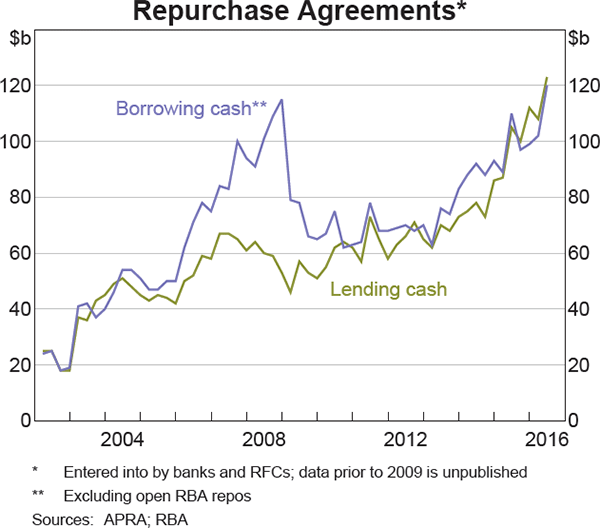
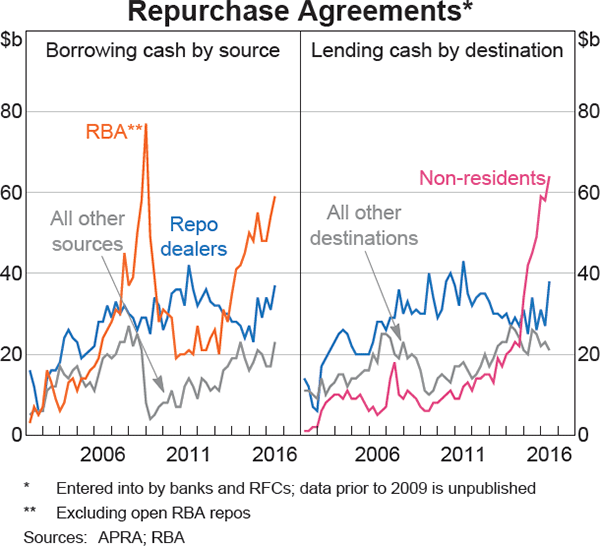
Over recent years there has also been a sharp increase in the gross cash lending position that repo dealers have with non-residents. As at the end of June 2012 non-residents were relatively minor participants, borrowing around $14 billion in cash in the repo market, but as at the end of June 2016 this had increased to over $60 billion (or around 50 per cent of total cash lending positions).
The increased participation of non-residents in the repo market has coincided with a rise in repo rates (Graph 3). Since June 2015, the repo rate at which the Reserve Bank conducts its open market operations has risen from a spread to overnight indexed swaps (OIS) of around 2 basis points, to around 20 basis points in September 2016. Elevated repo rates are also evident in major economies such as the United States, United Kingdom and Canada. The increase in repo rates in recent years can largely be attributed to different causes in different jurisdictions. The introduction of prudential regulations that require dealers to hold more capital against their market-making activities may have been a factor where the leverage ratio is a binding constraint (CGFS 2015). In Australia, this is less likely to be the main factor, given that the repo market is a relatively small share of the financial system. Instead, market developments related to the foreign exchange swap market and the bond futures market appear to be contributing to the recent increase in repo market activity by non-residents.
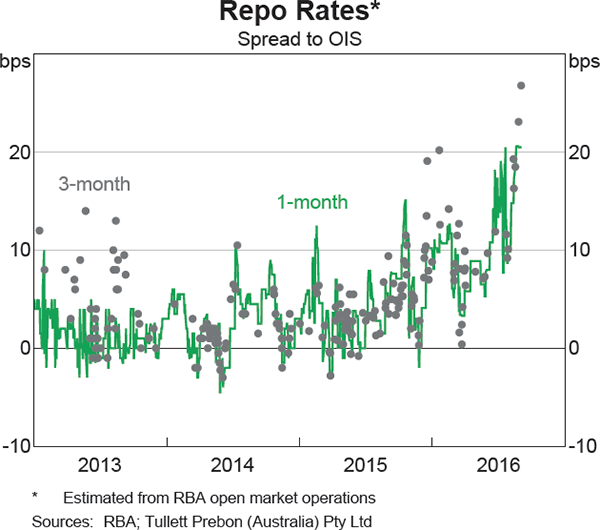
Foreign exchange swap basis
A common transaction that takes advantage of a trading opportunity in the foreign exchange swap market is a collateral swap.[5] Typically, a non-resident holder of AGS lends the securities for Australian dollar cash using a repo dealer as the intermediary.[6] These Australian dollars are then lent in the foreign exchange swap market in exchange for Japanese yen. The Japanese yen are then lent under repo against Japanese Government Bonds (JGBs). In effect, the non-resident has entered into a collateral swap of AGS for JGBs. Each of the transactions can be undertaken separately with different repo dealers, or it can be arranged by a single repo dealer that operates in both markets.
The transaction is profitable because of the foreign exchange swap basis.[7] This relates to the fact that holders of Japanese yen are willing to pay a premium (the basis) to enter into a foreign exchange swap to borrow foreign currency, in this case, the Australian dollar. This reflects the strong demand of Japanese residents to diversify their financial assets internationally, while limiting their exposure to movements of the exchange rate.
Investors who borrow Australian dollar cash can earn a premium of around 70 basis points if the proceeds are swapped into yen cash and then invested in Japanese assets at a three-month tenor (Graph 4).[8]
Hence these investors can be relatively insensitive to the cost of borrowing Australian dollars under repo because the yen basis is currently so wide. In this way, the non-resident demand for repo finance contributes to upward pressure on repo market rates. While the Japanese yen basis is also evident against other major currencies such as the US dollar and the euro, it may be playing a smaller role in explaining elevated repo rates in those larger markets. Importantly, there have been no flow-on effects from the upward pressure on repo rates to other money market rates, such as bank bills.
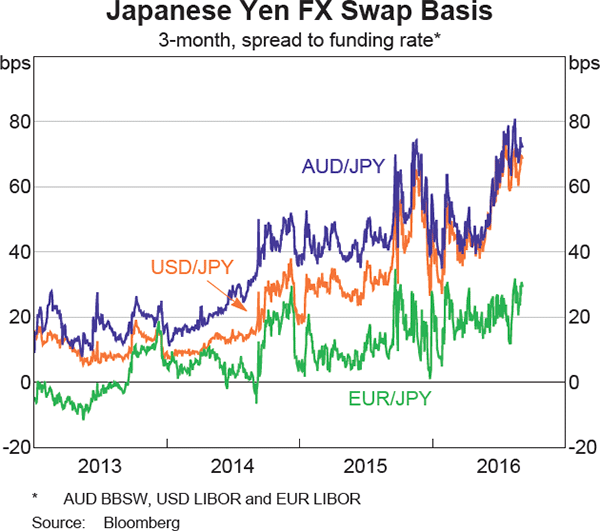
Bond futures market basis
There are also arbitrage opportunities in the Australian bond futures market that involve the repo market. One relates to differences between the price of AGS and their implied price in the ASX bond futures market. Resident and non-resident investors who seek to acquire a long positon in AGS and a short position in the bond futures contract can use the repo market to fund these arbitrage trades; as an incremental source of demand for repo cash borrowing, this could put some upward pressure on repo rates.
Over recent years, trading in ASX bond futures has regularly implied a higher price (lower yield) for the bonds in the reference basket than prevailing prices for those bonds in the physical market (Graph 5). This may be partly explained by the greater liquidity in the futures market, which provides market participants with a leveraged exposure to the AGS market without incurring the cost of holding securities. The difference in pricing between the two markets varies over time but tends to converge to zero as the contract approaches expiry, at which time the final settlement yield is defined as a composite of live market prices for the underlying bonds.
This gives rise to a trading opportunity, which is typically exploited via a strategy called ‘trading the basis’ (Figure 1). An investor initiates this trade by simultaneously selling bond futures (which are relatively overvalued) and purchasing physical bonds (which are relatively undervalued).[9] The investor can finance the long physical bond position by borrowing cash in the repo market against the bonds. To exit the trade, the investor closes these positions by buying back the futures, unwinding the repo and selling the physical bonds. This allows the investor to realise profits resulting from the convergence in futures and physical bond prices, as well as the reinvestment of any coupons paid by the bonds during the holding period.
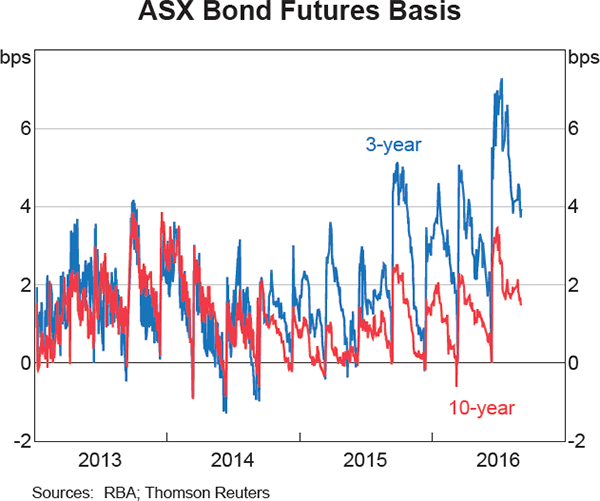
Because trading the bond futures basis often involves the financing of the long bond position via a repo, the repo rate is a key determinant of the profitability of this arbitrage strategy. Trading the basis is also a source of demand for securities financing in the repo market and can create upward pressure on repo rates. However, while repo rates have increased relative to OIS rates as shown in Graph 3, they do not appear to be a significant constraint on the profitability of the bond futures basis trade in the current environment.
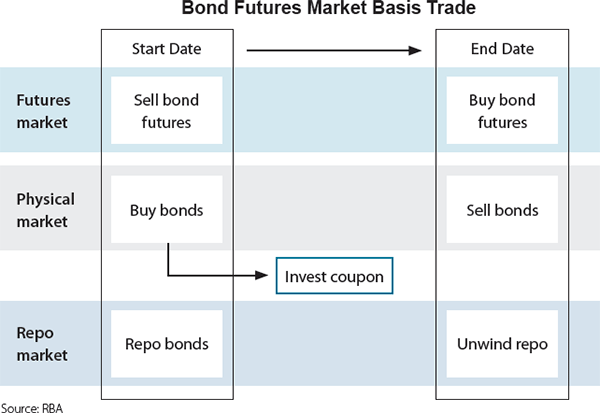
This reflects that the implied repo rate from the bond futures contract, which would eliminate the basis, is considerably higher than the actual repo rate an investor pays to finance their long bond position. To illustrate this, Table 2 shows what the bond futures basis would be at a range of repo rates (a positive basis indicates overvalued bond futures relative to physical bonds). On the day of the example, the repo rate was around 1.79 per cent, which would imply a basis of 2.66 basis points; the repo rate would have needed to be almost 1 percentage point higher for the basis to close.[10]
| Repo rate Per cent | Basis Bps |
|---|---|
| 1.50 | 3.53 |
| 1.75 | 2.77 |
| 2.00 | 2.02 |
| 2.25 | 1.26 |
| 2.50 | 0.51 |
| 2.75 | −0.25 |
| 3.00 | −1.00 |
|
Source: RBA |
|
Conclusion
A well-functioning repo market supports the efficient functioning of financial markets. Understanding the repo market is therefore important to interpreting market developments, as well as the implementation of monetary policy. Consistent with this, the Reserve Bank has recently begun publishing data that allows users, including the Reserve Bank itself, to better understand the repo market in Australia.
The size of outstanding positions in the repo market has grown considerably in recent years. This primarily reflects an increase in the size of the Reserve Bank's repo book, as well as non-residents emerging as prominent borrowers of cash in return for securities. While the former is the result of day-to-day central bank liquidity management, the latter appears to be related to arbitrage of the basis that exists in both the foreign exchange swap market and Australian bond futures market. Growing demand from non-residents to fund these trading activities has contributed to a noticeable increase in repo rates. Changes in regulatory requirements and the business practices of market participants may also have played a role, but are likely to have been less important than in other advanced economies.
Footnotes
The authors are from Domestic Markets Department. [*]
Viewed from the cash lender's perspective the transaction is a reverse repo. The annualised percentage difference between the sale price and the repurchase price is the repo rate. For further discussion refer to Wakeling and Wilson (2010), Cheung, Manning and Moore (2014), as well as RBA (2015). [1]
Cash refers to settlement balances that market participants transfer between each other, rather than banknotes. These are typically Exchange Settlement balances that the largest repo dealers hold at the Reserve Bank. [2]
Secured financing transactions may also be undertaken under securities lending agreements, although equities are usually provided as collateral. In contrast to repos, under securities lending the economic benefits of the security are generally passed through to the recipient. This segment of the market is relatively small in Australia. A range of global securities lending transactions and market trends are described in more detail by Dive, Hodge and Jones (2011). [3]
Refer to statistical table B3 Repurchase Agreements and Stock Lending by Banks and RFCs. Additional information related to the Reserve Bank's activity in the repo market is published in statistical table A3 Open Market Operations. These data are available at <http://www.rba.gov.au/statistics/tables/>. For a definition of RFCs and discussion of their activities, see RBA (2012). [4]
This is just one of a number of strategies that take advantage of the existence of the Japanese yen swap basis. [5]
Non-residents currently hold about 60 per cent of outstanding AGS. [6]
For a more detailed discussion of the Japanese yen basis, see BIS (2016). [7]
The foreign exchange basis is expressed as a spread to a benchmark rate, such as the London Interbank Offered Rate (LIBOR) or the Australian Bank Bill Swap Rate (BBSW). [8]
Investors will typically calibrate the notional value transacted in the futures market relative to that in the physical market in order to offset interest rate risk. This calculation will depend on the specific features of the futures contract and underlying bonds, as well as prevailing market yields. [9]
The 3-month OIS rate plus the open market operations cut-off rate spread to OIS on that day is used as an indicative repo rate. [10]
References
Baker A and D Jacobs (2010), ‘Domestic Market Operations and Liquidity Forecasting’, RBA Bulletin, December, pp 37–43.
CGFS (Committee on the Global Financial System Markets Committee) (2015), Regulatory Change and Monetary Policy, CGFS Papers No 54, Bank for International Settlements, Basel.
BIS (Bank for International Settlements) (2016), ‘Box II.C Understanding the Cross-Currency Basis: Why does Covered Interest Parity not Hold?’, BIS 86th Annual Report, pp 40–42.
Cheung B, M Manning and A Moore (2014), ‘The Effective Supply of Collateral in Australia’, RBA Bulletin, September, pp 53–66.
Dive M, R Hodge and C Jones (2011), ‘Developments in the Global Securities Lending Market’, Bank of England, Quarterly Bulletin, Q3, pp 224–233.
RBA (Reserve Bank of Australia) (2012), ‘Box D: A Closer Look at the Shadow Banking System in Australia’, Financial Stability Review, March, pp 69–72.
RBA (2015), ‘The Australian Repo Market’, in Central Clearing of Repos in Australia: A Consultation Paper, Reserve Bank of Australia, Sydney, March, pp 4–11.
Wakeling D and I Wilson (2010), ‘The Repo Market in Australia’, RBA Bulletin, December, pp 27–35.